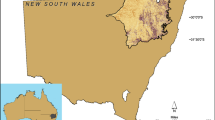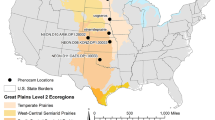Abstract
Predictive modeling of vegetation patterns has wide application in vegetation science. In this paper I discuss three methods of predictive modeling using data from the alpine treeline ecotone as a case study. The study area is a portion of Glacier National Park, Montana. Parametric general linear models (GLM), artificial neural networks (ANN) and classification tree (CT) methods of predicting vegetation type are compared to determine the relative strength of each predictive approach and how they may be used in concert to increase understanding of important vegetation – environment relations. For each predictive method, vegetation type within the alpine treeline ecotone is predicted using a suite of environmental indicator variables including elevation, moisture potential, solar radiation potential, snow potential index, and disturbance history. Results from each of the predictive methods are compared against the real vegetation types to determine the relative accuracy of the methods.
When the entire data field is examined (i.e., not evaluated by smaller spatial aggregates of data) the ANN procedure produces the most accurate predictions (κ=0.571); the CT predictions are the least accurate (κ=0.351). The predicted patterns of vegetation on the landscape are considerably different using the three methods. The GLM and CT methods produce large contiguous swaths of vegetation types throughout the study area, whereas the ANN method produces patterns with much more heterogeneity and smaller patches.
When predictions are compared to reality at catchment scale, it becomes evident that the accuracy of each method varies depending upon the specific situation. The ANN procedure remains the most accurate method in the majority of the catchments, but both the GLM and PCT produce the most accurate classifications in at least one basin each.
The variability in predictive ability of the three methods tested here indicates that there may not be a single best predictive method. Rather it may be important to use a suite of predictive models to help understand the environment – vegetation relationships. The ability to use multiple predictive methods to determine which spatial subunits of a landscape are outliers is important when identifying locations useful for climate change monitoring studies.
Similar content being viewed by others
References
Allen, T. R. & Walsh, S. J. 1996. Spatial and composition pattern of alpine treeline, Glacier National Park, Montana. Photogr. Eng. Remote Sensing 62: 1261-1268.
Armand, A. D. 1992. Sharp and gradual mountain timberlines as a result of species interaction. Pp. 360-378. In: Hansen, A. J. & di Castri, F. (eds), Landscape Boundaries: consequences for biotic diversity and ecological flows. Springer-Verlag, New York.
Ayres, H. B. 1898. The flathead forest reserve. U.S. Geological Survey 20th Annual Report, G.P.O.,Washington, D.C.
Baker, W. L., Honaker J. J. & Weisberg, P. J. 1995. Using aerial photography and GIS to amp the forest-tundra ecotone in Rocky Mountain National Park, Colorado, for global change research. Photogr. Eng. Remote Sensing 61: 313-320.
Barry, R. G. 1981. Mountain weather and climate. Methuen, New York.
Benediktsson, J. A., Swain, P. H. & Ersoy, O. K. 1990. Neural network approaches versus statistical methods in classification of multisource remote sensing data. IEEE Trans. Geosci. and Remote Sensing 28: 540-552.
Beven, K. J. & Kirkby, M. J. 1979. A physically-based variable contributing area model of basin hydrology. Hydrol. Sci. Bull. 24: 43-69.
Bishop, Y. M. M., Fienberg, S. E. & Holland, P. W. 1975. Discrete multivariate analysis: theory and practice. The MIT Press, Cambridge, MA.
Brown, D. G. 1991. Topoclimatic models of an alpine environment using digital elevation models within a GIS. Proceedings of GIS:LIS '91, Atlanta, pp. 835-844.
Brown, D. G. 1994. Predicting vegetation types at treeline using topography and biophysical disturbance variables. J. Veg. Sci. 5: 641-656.
Brown, D. G. and Bara, T. J. 1994. Recognition and reduction of systematic error in elevation and derivative surfaces from 7-1/2 minute DEMs. Photogr. Eng. Remote Sensing 60: 189-194.
Brown, D. G., Lush, D. P. & Duda, K. A. 1998. Supervised classification of types of glaciated landscapes using digital elevation data. Geomorphology 21: 233-250.
Butler, D. R., Malanson, G. P. & Walsh, S. J. 1992. Snow avalanche paths: conduits from the periglacial alpine to the subalpinedepositional zone. Pp. 185-202. In: Dixon, J. C. A. & Abrahams, A. D. (eds), Periglacial geomorphology. John Wiley and Sons, New York.
Butler, D. R. & Walsh, S. J. 1990. Topographic, structural, and lithologic influences of snow avalanche path location, eastern Glacier National Park, Montana. Ann. Assoc. Am. Geogr. 80: 362-378.
Butler, D. R. & Walsh, S. J. 1994. Site characteristics of debris flows and their relationship to alpine treeline. Phys. Geogr. 15: 181-199.
Cairns, D. M. 1998. Modeling controls on pattern at alpine treeline. Geogr. Environ. Model. 2: 37-56.
Cairns, D. M. 1999. Multi-scale analysis of soil nutrients at alpine treeline in glacier national Park, Montana. Phys. Geogr. 20: 256-271.
Cairns, D. M. & Malanson, G. P. 1997. Examination of the carbon balance hypothesis of alpine treeline location in Glacier National Park, Montana. Phys. Geogr. 18: 125-145.
Cairns, D. M. & Malanson, G. P. 1988. Environmental variables influencing carbon balance at the alpine treeline ecotone: a modeling approach. J. Veg. Sci. 8: 679-692.
Carrara, P. E. 1990. Surficial geology. Glacier National Park, Montana. USGS Miscellaneous Investigations Series. MAP I-1508-D. Reston, VA.
Civco, D. L. 1993. Artificial neural networks for land cover classifi-cation and mapping. Int. J. Geogr. Inf. Systems 7: 173-186.
Cohen, J. 1960. A coefficient of agreement of nominal scales. Educ. Psychol. Meas. 20: 37-46.
Congalton, R. G. 1991. A review of assessing the accuracy of classifications of remotely sensed data. Remote Sensing Environ. 37: 35-46.
Finklin, A. I. 1986. Climatic Handbook for Glacier National Park-with Data for Waterton Lakes National Park. USDA Forest Service General Technical Report, INT-204, Intermountain Research Station, Ogden UT.
Franklin, J. 1995. Predictive vegetation mapping: Geographic modelling of biospatial patterns in relation to environmental gradients. Prog. Phys. Geogr. 19: 474-499.
Hansen, A. J., di Castri, F. & Risser, P. G. 1988. A new SCOPE project. Ecotones in a changing environment: the theory and management of landscape boundaries. Biol. Int. 17: 137-163.
Hansen, A. J., Risser, P. G. & di Castri, F. 1992. Epilogue: biodiversity and ecological flows across ecotones. Pp. 423-438. In: Hansen, A. J. & di Castri, F. (eds), Landscape boundaries. Springer-Verlag, New York.
Hara, Y., Atkins, R. G., Yueh, S. H., Shin, R. T. & Kong, J. A. 1994. Application of neural networks to radar image classification. IEEE Trans. Geosci. Remote Sensing 32: 100-109.
Hattenschwiler, S. & Smith, W. K. 1999. Seedling occurrence in alpine treeline conifers: a case study from the central Rocky Mountains, USA. Acta Oecol. 20: 219-224.
Hepner, G. F., Logan T., Ritter, N. & Bryant, N. 1990. Artificial neural network classification using a minimal training set: Comparison to conventional supervised classification. Photogr. Eng. Remote Sensing 56: 469-473.
Kullman, L. 1993. Pine (Pinus sylvestris L.) tree-limit surveillance during recent decades, central Sweden. Arct. Alp. Res. 25: 24-31.
Kupfer, J. A. & Cairns, D. M. 1996. The suitability of montane ecotones as indicators of global climatic change. Progr. Phys. Geogr. 20: 253-272.
Lippman, R. 1987. An introduction to computing with neural nets. IEEE Acoust. Speech Signal Process Mag. 4:4-22.
Malanson, G. P. & Butler, D. R. 1994. Tree-tundra competitive hierarchies, soil fertility gradients, and treeline elvation in Glacier National Park, Montana. Phys. Geogr. 15: 166-180.
MathSoft 1998. S-Plus 5 for Unix Guide to Statistics. MathSoft, Seattle, WA.
Michaelsen, J., Schimel, D. S., Friedl, M. A., Davis, F. W. & Dubayah, R. C. 1994. Regression tree analysis of satellite and terrain data to guide vegetation sampling and surveys. J. Veg. Sci. 5: 673-686.
Noble, I. R. 1993. A model of the responses of ecotones to climate change. Ecol. Appl. 3: 396-403.
Paola, J. D. & Schowengerdt, R. A. 1993. A review and analysis of neural networks for classification of remotely sensed multispectral imagery. Research Institute for Advanced Computer Science, NASA Ames Research Center Tech. Rep., 93.05 (NASA-CR-194291), Paola, J. D. & Schowengerdt, R. A. 1995. A detailed comparison of backpropagation neural network and maximumlikelihood classifiers for urban land use classification. IEEE Trans. Geosci. Remote Sensing 33: 981-996.
Tranquillini, W. 1979. Physiological ecology of the alpine Timberline: tree existence at high altitudes with special references to the European Alps. Springer-Verlag, New York.
Venables, W. N. & Ripley, B. D. 1999. Modern Applied Statistics with S-PLUS. Springer-Verlag, New York.
Walsh, S. J., Malanson, G. P. & Butler, D. R. 1992. Alpine treeline in Glacier National Park, Montana. Pp. 167-171. In: Janelle, D. G. (ed.), Geographical snapshots of North America. Guilford Press, New York.
Weisberg, P. J. & Baker, W. L. 1995. Spatial variation in tree seedling and krummholz growth in the forest-tundra ecotone of Rocky Mountain National Park, Colorado, USA. Arct. Alp. Res. 27: 116-129.
Author information
Authors and Affiliations
Rights and permissions
About this article
Cite this article
Cairns, D.M. A comparison of methods for predicting vegetation type. Plant Ecology 156, 3–18 (2001). https://doi.org/10.1023/A:1011975321668
Issue Date:
DOI: https://doi.org/10.1023/A:1011975321668




